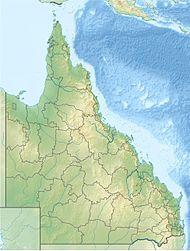| Edmund Kennedy National Park Queensland | |
|---|---|
IUCN category II (national park) | |
| Nearest town or city | Tully |
| Coordinates | 18°02′41″S 146°01′41″E / 18.04472°S 146.02806°E |
| Established | 1977 |
| Area | 69.5 km2 (26.8 sq mi) |
| Managing authorities | Queensland Parks and Wildlife Service |
| Website | Edmund Kennedy National Park |
| See also | Protected areas of Queensland |
Edmund Kennedy is a national park in Queensland, Australia, 1269 km northwest of Brisbane. The national park is part of the Wet Tropics World Heritage Area. It was named after Edmund Kennedy, a mid-nineteenth century explorer.
The park protects part of the coastline between the mouths of the Tully River and Meunga Creek at Rockingham Bay.[1] Waters adjacent to the park belong to the Great Barrier Reef Marine Park.
Flora
The coastal plain contains mangrove and freshwater swamps associated with the waterways of Murray River, Dallachy Creek and Wreck Creek.[1] Other vegetation types include low coastal rainforest, eucalyptus forest, melaleuca woodland and sedge swamp.[2] The Arenga palm grows here, one of only a few Australian mainland locations where this occurs.[1] The Red Beech, pandanus and melaleucas are typically found in the park.[3]
Fauna
The endangered southern cassowary and mahogany glider are found in the park.[2] Saltwater crocodiles are found in the creeks.[1] The park is part of the Coastal Wet Tropics Important Bird Area, identified as such by BirdLife International because of its importance for the conservation of lowland tropical rainforest birds.[4] Common birds include the black butcherbird and various honeyeaters. The orange-footed scrubfowl nests in the park. Their mounds, which can be up to three m high, are the largest of all mound-building birds in Australia.[1] Lace monitor lizards can also be seen in Edmund Kennedy National Park.[2]
Feral pigs and cattle have to be culled from the area.
History
The land was once home to the Girramay people.[3] In 1848, explorer Edmund Kennedy and his party landed 35 km north of the park. He travelled south through the area now known as Edmund Kennedy National Park in a failed attempt to find passage over the ranges behind the coast.[3]
It was expanded in 1980 by land donated by conservation activists Margaret and Arthur Thorsborne. In 2011, Cyclone Yasi caused significant damage to the area.
Facilities
Camping is not permitted in the park.[1] Picnic facilities including tables and toilets are available. A boardwalk through mangroves and another along Wreck Creek are graded as easy.[5]
Access
The park can be reached by an entrance road four km north of Cardwell on the Bruce Highway.[1]
See also
References
- ^ a b c d e f g Shilton, Peter (2005). Natural Areas of Queensland. Mount Gravatt, Queensland: Goldpress. pp. 60–63. ISBN 0-9758275-0-2.
- ^ a b c "Edmund Kennedy National Park". Queensland Holidays. Tourism Queensland. Retrieved 12 July 2011.
- ^ a b c "Edmund Kennedy, Girramay National Park: Nature, culture and history". Department of National Parks, Recreation, Sport and Racing. 7 June 2011. Retrieved 6 October 2014.
- ^ BirdLife International. (2011). Important Bird Areas factsheet: Coastal Wet Tropics. Downloaded from "Archived copy". Archived from the original on 30 June 2007. Retrieved 2012-12-19. on 2011-12-16.
- ^ "About Edmund Kennedy". Department of National Parks, Recreation, Sport and Racing. 7 June 2011. Retrieved 6 October 2014.
External links
- Edmund Kennedy National Park - Department of Environment and Resource Management
